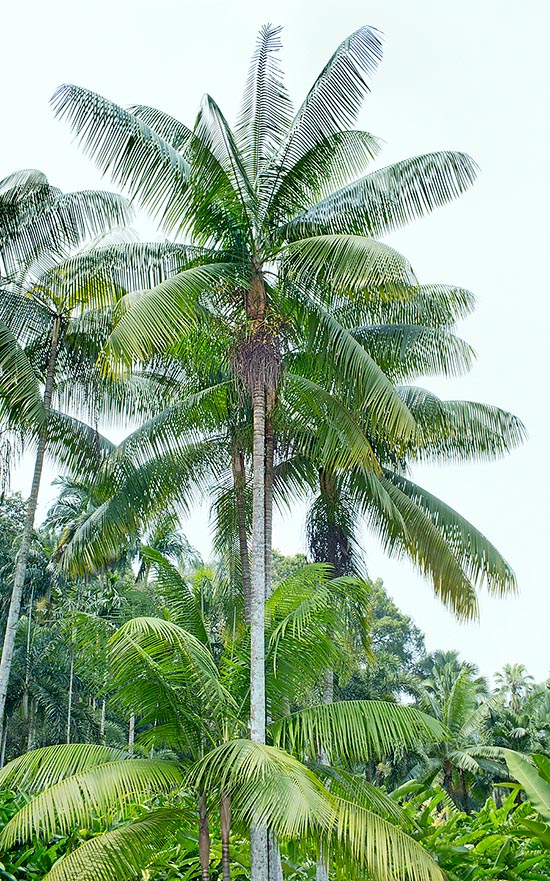Family : Arecaceae

Text © Pietro Puccio

English translation by Mario Beltramini

Even 30 m tall and with 30 cm stem, Rhopaloblaste augusta is a rare Nicobar Islands palm where it grows in the pluvial forests at low altitudes. Little cultivated in tropics, stands among the most ornamental in absolute due to the showy elegance of the foliage and coloured infructescences © Giuseppe Mazza
The species is native to the Nicobar Islands where it grows in the pluvial forests at low altitudes, exceeding in height all other trees.
The name of the genus is the combination of the Greek substantives “ρόπαλον” (rhopalon) = club, bat and “βλαστός” (blastos) = embryo with reference to its shape; the specific name is the Latin adjective = “augustus, a, um” august, majestic.
Common names : Nicobar majestic palm (English).
The Rhopaloblaste augusta (Kurz) H.E.Moore (1970) is an unarmed monoecious species with erect single stem, up to 30 m tall and of 20-30 cm of diameter, of brown colour in the youngest part, greyish in the oldest one, on which are visible the rings traces of the junction of the fallen leaves.
The leaves, on short petiole covered by tiny rusty scales, about 10 cm long, are pennate, 3-4 m long, with the foliar base, covered by a thin pale brown tomentum, wholly wrapping the stem for a height of about 60 cm forming a sort of tubular capital. The pinnules, 90-100 on each side, are linear with pointed apex, regularly arranged on the rachis, drooping, about 70 cm long and 2-3 cm broad in the median part, of glossy dark geen colour above, spotted by tiny brown scales below.
The inflorescences, on short peduncle, enclosed in the initial growth phase in a deciduous spate, are ramified, 40-60 cm long, placed under the leaves (infrafoliar), with unisexual flowers arranged in groups of three (a female flower between two male ones) of greenish colour. The fruits are ellipsoid, of 2,4-2,6 cm of length and of 1,2-1,5 cm of diameter, red orange when ripe, with mesocarp formed by flat longitudinal fibres, containing only one ellipsoid seed of 1,5 cm of length and 1 cm of diameter.
It reproduces by seed, previously cleaned from the pulp and kept in lukewarm water for 4-5 days, in aerated and draining loam maintained humid at the temperature of 26-28 °C, with germination times of 6 or more months; the first leaflet is pennate with 7-9 pinnules per side.
Palm among the most ornamental in absolute due to the elegance of the foliage and the coloured infructescences, now rare in nature due to the excessive anthropization and still little diffused elsewhere, of great landscape effect in groups of several specimens of different height in parks and big gardens or in line at the borders of roads and alleys, cultivable exclusively in the humid tropical climate zones and marginally in the subtropical ones. It requires an exposition in full sun, but in the juvenile phase when it needs a slight shade, sheltered from the winds, and is not particular about the soil, provided the same is well drained and kept constantly humid.
The stems were utilized by the local populations for building the structure of the roofs of their houses. The species is inserted in the red list of IUCN (International Union for the Conservation of Nature) as “ vulnerable” (species at extinction risk in nature).
Synonyms : Areca augusta Kurz (1875); Ptychoraphis augusta (Kurz) Becc. (1885).
→ For general notions about ARECACEAE please click here.
